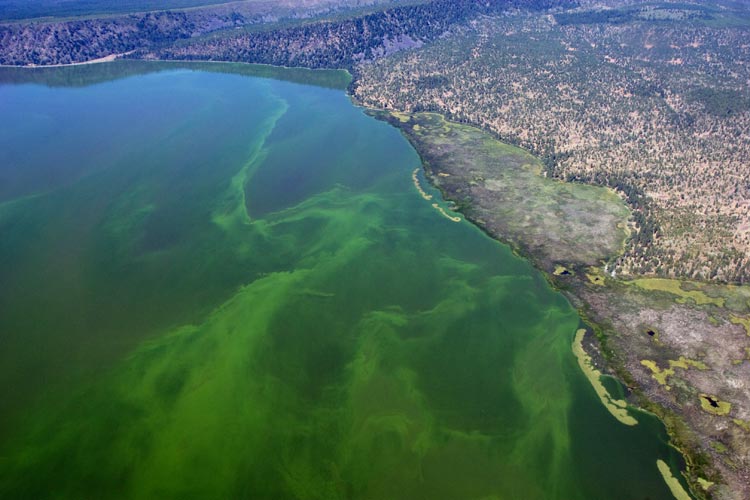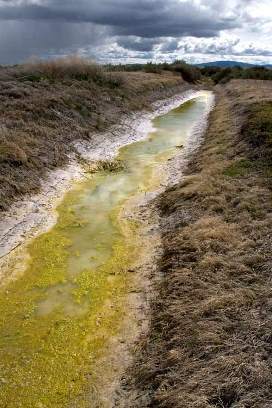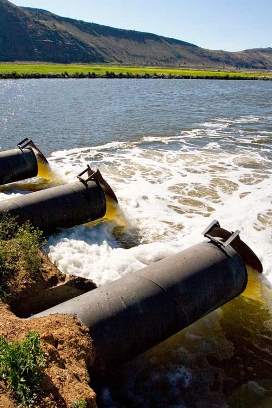In 2008, the California State Water Resource Control Board noted that conditions on the Klamath River indicate an ongoing “decline in the river’s water quality and ability to support healthy fisheries.” The Board also acknowledges that the river has seen noteworthy increases in toxic blue-green algae and a general decline in fish populations. Toxic water quality in the Klamath River is a direct result of both upper basin agricultural development (the draining of wetlands and intense chemical use), and the presence of PacifiCorp's dams, creating warm, stagnant pools for algae to develop.
 Massive algae pools in Upper Klamath Lake.
Massive algae pools in Upper Klamath Lake. Male Ruddy Duck in algae on Lower Klamath National Wildlife Refuge.
Male Ruddy Duck in algae on Lower Klamath National Wildlife Refuge. Algae pools in a Lower Klamath irrigation ditch.
Algae pools in a Lower Klamath irrigation ditch. Water pumps on the Tule Lake National Wildlife Refuge.
Water pumps on the Tule Lake National Wildlife Refuge.
A history of point and non-point source pollution in the waters of the Klamath Basin indicate that water quality challenges in the basin watershed, rivers, and tributaries are not temporary. Instead, this problem should be addressed with more considerate and long-term solutions, including the restoration of the basin's wetlands, the removal of the Klamath's lower four dams, and proper water quality certification of the Klamath River.
A long history of pollution in the Klamath River, as a result of nutrient loading in the basin, has led to fish kills and water quality challenges in the reservoirs of the Klamath Hydroelectric Project. While some argue that algal pollution has been present in the Klamath River prior to the PacifiCorp Klamath Hydroelectric Project (specifically at Copco and Iron Gate dam reservoirs), there is considerable evidence that dams both cause and exacerbate toxic pollution. The notable and harmful impacts of cyanobacterial species Microcystis aeruginosa, which produce microcystin toxins, are many and sampling evidence points directly to the impacts of the Klamath Hydroelectric Project reservoirs.
Microcystin toxins, released by toxic algae, pose significant health risks. Microcystin toxins are known to cause harmful results ranging from skin rashes and fevers to livestock poisoning and liver toxicity. Sampling of microcystin toxins in several locations in the Iron Gate and Copco reservoirs of the KHP since 2004 have revealed hazardous levels of toxic algae above the World Health Organization recommendation. During July-September of 2005, samples exceeded World Health Organization levels by 10-100 times. Later sampling in July and August of 2006 revealed that one site exceeded the World Health Organization moderate-risk-exposure standard by 3,900 times.
Cleaning up the Klamath River has become a priority of both regional and state water boards in California, as well as the communities that live along and work for the Klamath River.

